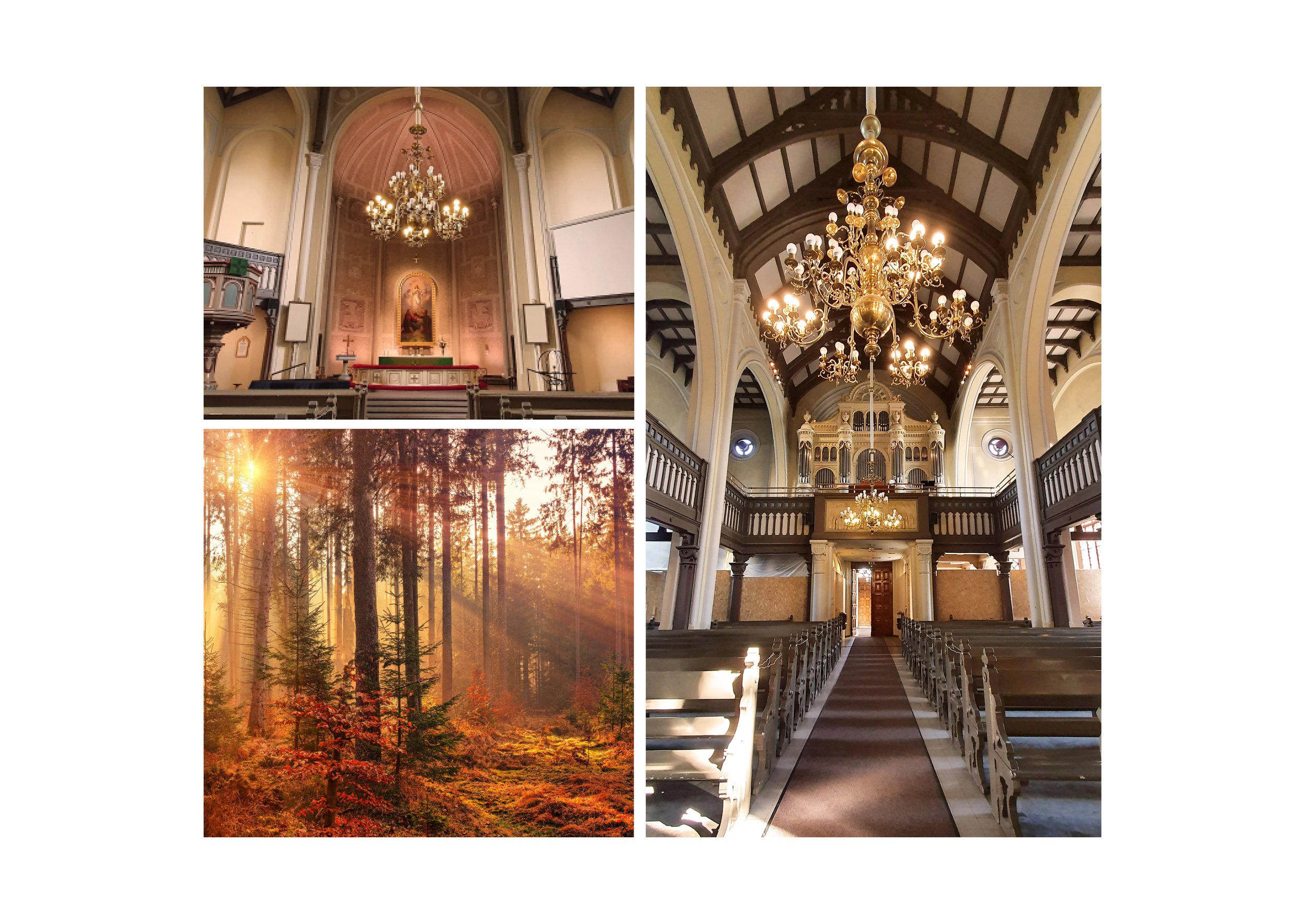A tree that protects
The baptismal tree is a sculptural, symbolic tree located inside the church, serving as part of worship services and baptism ceremonies. The names of the baptized are attached to the tree as leaves, symbolically connecting the baptized individuals to the congregation. I had the honor to design and create the baptismal tree for Tampere's Aleksanteri Church, which was unveiled on the first Sunday of Advent in 2022.
A type of sculpture called a “baptism tree” (try googling images for kastepuu in Finnish) can be found in many Finnish congregations, although not in all of them. It is common for the tree to be made of plywood and the leaves to be made of cardboard. At the end of the year, the leaves are collected and sent to the families of the baptized. However, this church in Tampere, Finland wanted to do things differently. The baptismal tree will become a permanent part of the architecture of the 140-year-old church, and the names attached on the tree during baptism will remain in place, enriching the tree's appearance as the decades pass. My proposal, "A Tree that Protects," won the competition for the design of the baptism tree sculpture. The idea behind the artwork is that faith, whatever it personally means to each individual, is something that brings comfort and a feeling of being protected. This is a tree that welcomes people to its shelter.
On this page, I will share the background of the artwork. I have been sharing pictures of the journey and the process of creating the artwork on Instagram, @sculptor_maija_kovari
Artist among the branches of the artwork. Photo: Elisa Niittylä.
“Instead of viewing the tree from the front, the artwork takes the perspective from which a person experiences the view from the shelter of the tree towards the sky. The symbolism behind this is that faith, whatever it personally means to each individual, is something that brings a feeling of protection and peace.”
Starting points
The Aleksander Church, consecrated on Advent in 1881, was the main church of the newly established city parish of Tampere. Surrounding the church is Pyynikki Church Park, which was designed by the city gardener of Tampere at the time, and it was planted with various trees such as silver willows, Siberian larches, and oaks. Many of these old trees still remain, and today the park is home to, among others, the thickest European larch in Finland, with a circumference of approximately five meters.
Church Facade in wintertime
“Our forests can be seen as the first Finnish church and one that remains an invaluable place of silence and peace for many Finns.”
The interior of Aleksander Church has a warm color palette. Above are a few photographs taken inside the church, as well as an inspirational image of an autumn forest. The forest can be seen as the first Finnish church that remains an invaluable place of silence and peace for many of us.
“In my mind, the sculpture becomes part of the old forest surrounding the church”
When designing the artwork, I photographed the trees in the park surrounding the church, observing them as I looked through their branches towards the sky and the sunlight. I also studied how the branches of the trees cast shadows on the walls. Some shadows were sharp, while others were soft, depending on the distances between the branches. Similarly, when looking up through the foliage, one can see branches at different levels of clarity, with those closer appearing more distinct than those further away. The baptism tree inside the church takes its form from these observations. The tree consists of layered foliage that extends from one edge of the allocated space to the other. In my mind, the sculpture is thus constructed as a part of the old existing tree population surrounding the church, becoming a part of it.
Above: The park surrounding the church is old indeed! The black and white photograph above is over a hundred years old, and it shows already mature trees surrounding the church.
In the right-hand image above, you can see various shadows cast by the trees on the walls. I captured many such shadow images and videos during the design process of the artwork. This particular photo was taken of a yellow house on Sotkankatu street near the church.
Below: The artwork consists of layers that resemble foliage, positioned closely together on the wall, approximately 10 centimeters apart. These layers create structure and depth for the baptismal tree, which will be further enriched over the years by the leaves hung on it. The basis for these images is an old oak tree that I photographed in the park surrounding the church.
The baptismal tree in Aleksanteri Church is realized as a wall relief, located on the wall to the right of the altar. At this specific spot on the wall, there is a recess that creates a window-like structure, and the artwork is implemented within this recess.
Site of the work in layout of the church marked with “Kastepuu”
Space before the artwork was built.
In the realization of the baptismal tree, spaces have been created for the names of future baptizees for approximately a hundred years. The artwork includes a total of 10,000 spaces for the names of future baptizees, along with 10,000 leaves that have been prepared and stored in the church vaults for baptisms in the coming decades. The appearance of the baptismal tree will thus become richer year by year as new names are hung on its foliage. Eventually, the baptismal tree will contain a total of 10,000 leaves with names, spanning multiple generations.
“The artwork includes a total of 10,000 spaces for the names of future baptizees, along with 10,000 leaves that have been prepared and stored in the church vaults for baptisms in the coming decades.”
One of the most crucial aspects of the artwork's design was to accommodate the 10,000 leaves within a space of approximately 3 x 3 meters. Simultaneously, a fastening technique had to be developed for the leaves that is easy to use and durable for the intended lifespan of 100 years for the baptismal tree. Below are some sketches, scale models, and prototypes that I have created.
“As the sculpture is used as part of the Sunday service, or even as part of the baptism celebration of a child, it can be an exciting situation for the parents or siblings that attach the leaf in the tree. So I wanted it to be as easy to use as possible. Through various material tests, I selected brass as the material for the artwork and developed an attachment mechanism for the leaves that is as simple as possible so that the focus can be in the celebration. ”
Below is a short video of a prototype that illustrates both the material and the attachment mechanism I designed for the leaves.
Making of
In the sculpture, in addtition to the ones added to it over generations, I prepared existing leaves as part of the foliage, that have been manually bent out of brass. In the picture, the artist is working on the artwork with a small pry bar. Photo: Elisa Niittylä.
The baptismal tree consists of parts that have been fitted together in layers. In the picture, the artist is finishing the edge surface of one part by sanding. Photo: Elisa Niittylä.
Finishing touches. Photo: Elisa Niittylä.
One leaf attached to the work.
Leaves that were designed as part of the sculpture by Kovari
Thank you!
The artwork is a permanent part of the architecture and can be viewed in the church during its opening hours. In the map below, you can see the location of the church in the center of Tampere, in Pyynikki Church Park. You can find the current opening hours on the church's website. For the year 2023, the opening hours are Monday to Friday from 11 am to 6 pm, Saturdays according to activities, and Sundays from 10 am to 3 pm.

























